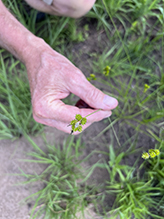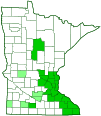Muhlenberg’s sedge
(Carex muehlenbergii var. muehlenbergii)
Conservation • Description • Habitat • Ecology • Use • Distribution • Taxonomy
Conservation Status |
|
|||||||
| IUCN Red List | not listed |
|||||||
| NatureServe | NNR - Unranked SNR - Unranked |
|||||||
| Minnesota | not listed |
|||||||
Description |
||
Muhlenberg’s sedge occurs in the United States east of the Great Plains, in southern Ontario Canada, and in Mexico. In Minnesota it is restricted to the southeast and Metro regions. There are a handful of scattered records farther west reported only on iNaturalist, but these may be misidentifications. It is found in sandy prairies and fields and other grasslands, on dunes, in dry, open, upland forests and woodlands, along railroads, and on roadsides. It grows under full or partial sun in moderately moist to dry sandy soil. It prefers barren areas where there is little competition from other plants. Muhlenberg’s sedge is an 8″ to 36″ (20 to 90 cm) tall, erect, perennial sedge that rises in a tuft or clump from a short, poorly developed underground stem (rhizome). The rhizome is dark, woody, and up to 2⅜″ (6 cm) long. Within the tuft, each Individual plant has a cluster of basal leaves and a single unbranched flowering stem. Basal leaves are sometimes reduced to almost bladeless sheaths. Stem leaves are restricted to the lower half of the culm. The lower part of each leaf that surrounds the stem (sheath) is tight around the stem, green, and sometimes inconspicuously mottled with white. The front of the sheath is thin and more or less transparent (membranous). The tip is concave. The mouth is yellowish and thickened. The inner side is papery white or almost white, and is not wrinkled crosswise, rarely inconspicuously wrinkled crosswise. The sheaths are persistent, they do not break up at maturity. The lowermost sheaths are brown to dark brown. The membrane where the leaf meets the stem (ligule) is U-shaped or V-shaped and up to ⅛″ (3 mm) long, usually wider than it is long. Each blade is ¾″ to 23½″ (2 to 60 cm) long, and 1⁄16″ to 3⁄16″ (2 to 5 mm) wide. It is green to light green, hairless, V-shaped in cross section, and flat or somewhat folded near the base. The upper surface is heavily covered with tiny, rounded bumps (papilla) making it rough to the touch and giving it a granular appearance. The flowering stem (culm) is three-angled, stiff, hairless, 8″ to 36″ (20 to 90 cm) tall, 1⁄16″ (1.7 to 2.2 mm) wide at the base, and 1⁄32″ (0.7 to 1.1 mm) wide at the top. It is as long or more often much longer than the leaves. The inflorescence is a ⅝″ to 1½″ (1.5 to 4.0 cm) long, 5⁄16″ to ½″ (8 to 12 mm) wide, compact cluster of 3 to 10 spikes at the end of the stem. The upper spikes are crowded but the lowermost spikes are separated so that the central axis is easily visible between the spikes. Each spike is subtended by a long, hair-like, modified leaf (bract). The lowermost bract is up to 1⅜″ (35 mm) long, the upper bracts are less than ¾″ (2 cm) long. Each spike is stalkless, is 3⁄16″ to ⅜″ (5 to 10 cm) long and ¼″ to ½″ (7 to 12 mm) wide, and has 8 to 20 female (pistillate) flowers. Each pistillate flower is entirely enclosed by a sac-like bract (perigynium) and subtended by a single scale. The scale is egg-shaped to broadly egg-shaped, ⅛″ (2.5 to 3.6 mm) long, and 1⁄16″ (1.6 to 2.0 mm) wide. It is narrower than and two-thirds as long as the perigynium. It is mostly transparent (hyaline) but has a green center with 3 veins. There is often a 1⁄64″ to 1⁄16″ (0.5 to 1.5 mm) long, stiff bristle (awn) at the tip. The perigynium is pale green to yellowish-brown, egg-shaped in outline, ⅛″ (3.5 to 4.2 mm) long and 1⁄16″to ⅛″ (2.2 to 3.6 mm) wide. The extended tip (beak) is 1⁄32″ (0.8 to 1.2 mm) long. It is minutely toothed toward the tip. The upper surface usually has 5 to 9 coarse veins, sometimes no veins. The lower surface almost always has 9 to 15 veins, rarely no veins. Two white stigmas emerge from a small opening at the tip of the perigynium. The stigmas are long, slender, and usually straight, sometimes coiled. The fruit is a dry, yellowish-brown, egg-shaped to almost circular in outline, one-seeded capsule (achene). It is 1⁄16″ (1.9 to 2.2 mm) long and 1⁄16″ (1.9 to 2.1 mm) wide, much smaller than the perigynium. The style drops off the achene as it matures, which is from late May to mid-August. |
||
Height |
||
8″ to 36″ (20 to 90 cm) |
||
Similar Species |
||
Habitat |
||
Moderately moist to dry. Prairies, fields, dunes, open upland forests and woodlands, railroads, and roadsides. Full or partial sun. Sandy soil. |
||
Ecology |
||
Maturing |
||
Late May to mid-August |
||
Pests and Diseases |
||
|
||
Use |
||
|
||
Distribution |
||||
|
Sources 2, 3, 4, 5, 8, 22, 24, 28, 29, 30, 84. The counties in light green represent questionable records reported only on iNaturalist. |
|||
| 10/19/2022 | ||||
Nativity |
||||
Native |
||||
Occurrence |
||||
|
||||
Taxonomy |
|||
| Kingdom | Plantae (Plants) | ||
| Division | Tracheophyta (Vascular Plants) | ||
| Subdivision | Spermatophytina (Seed Plants) | ||
| Class | Liliopsida (Monocots) | ||
Order |
Poales (grasses, sedges, cattails, and allies) | ||
Family |
Cyperaceae (sedges) | ||
| Subfamily | Cyperoideae | ||
| Tribe | Cariceae | ||
Genus |
Carex (true sedges) | ||
| Subgenus | Vignea | ||
| Section | Phaestoglochin | ||
Synonyms |
|||
Carex muhlenbergii |
|||
Common Names |
|||
Muhlenberg’s sedge sand bracted sedge sand sedge |
|||
Glossary
Achene
A dry, one-chambered, single-seeded seed capsule, formed from a single carpel, with the seed attached to the membranous outer layer (wall) only by the seed stalk; the wall, formed entirely from the wall of the superior ovary, does not split open at maturity, but relies on decay or predation to release the contents.
Awn
A stiff, bristle-like appendage at the tip of the glume, lemma, or palea of grass florets.
Beak
In plants: A comparatively short and stout, narrow or prolonged tip on a thickened organ, as on some fruits and seeds. In insects: The protruding, tubular mouthpart of a sucking insect.
Bract
Modified leaf at the base of a flower stalk, flower cluster, or inflorescence.
Culm
The hollow or pithy stem of a grass, sedge, or rush.
Ligule
In grasses and sedges, an outgrowth on the leaf at the junction of the blade and the sheath, usually membranous, sometimes no more than a fringe of hairs. In flowering plants, the ligule is the flat, strap-shaped, petal-like portion of the corolla of a ray floret.
Membranous
Thin, pliable, and more or less transparent.
Papilla
On plants: A tiny, rounded, nipple-like projection on the surface of a leaf or petal. On mushrooms: A small, raised, sharply pointed projection on the cap above the point of attachment with the stalk.
Perigynium
In Carex and other closely related sedges, a sac-like or flask-shaped, highly modified bract that surrounds the pistillate flower and later encloses the achene. Plural: perigynia.
Pistillate
Referring to a flower that has a female reproductive organ (pistil) but does not have male reproductive organs (stamens).
Rhizome
A horizontal, usually underground stem. It serves as a reproductive structure, producing roots below and shoots above at the nodes.
Scale
In plants: A small, usually flat and thin, modified leaf resembling the scale of a fish. In sedges: A dry, reduced bract at the base of the perianth. In animals: A small rigid plate growing out of an animal’s skin to provide protection. In butterflies and moths: A plate on the surface of the wing providing coloration.
Sheath
The lower part of the leaf that surrounds the stem.
Spike
The arrangement of an unbranched, elongated inflorescence with stalkless flowers that mature from the base toward the tip. In Cyperaceae, it also denotes a collection of one or a group of stalkless flowers, each subtended by scales, on a single inflorescence axis.
Stigma
In plants, the portion of the female part of the flower that is receptive to pollen. In Lepidoptera, an area of specialized scent scales on the forewing of some skippers, hairstreaks, and moths. In other insects, a thickened, dark, or opaque cell on the leading edge of the wing.
Visitor Photos |
|||||
Share your photo of this plant. |
|||||
| This button not working for you? Simply email us at info@MinnesotaSeasons.com. Attach one or more photos and, if you like, a caption. |
|||||
Nancy Falkum |
|||||
At TNC Cox Unit |
|||||
 |
|||||
MinnesotaSeasons.com Photos |
|||||
|
|||||

Slideshows |
||

Visitor Videos |
|||
Share your video of this plant. |
|||
| This button not working for you? Simply email us at info@MinnesotaSeasons.com. Attach a video, a YouTube link, or a cloud storage link. |
|||
Other Videos |
|||

Created: 10/20/2022
Last Updated:


